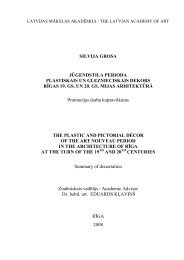Institute of Art History of the Latvian Academy of Art Anna Ancāne ...
Institute of Art History of the Latvian Academy of Art Anna Ancāne ...
Institute of Art History of the Latvian Academy of Art Anna Ancāne ...
Create successful ePaper yourself
Turn your PDF publications into a flip-book with our unique Google optimized e-Paper software.
approaching <strong>the</strong> classical examples <strong>of</strong> façade composition should be<br />
noted.<br />
3) Descriptions by contemporaries refute <strong>the</strong> idea <strong>of</strong> Baroque Riga having<br />
a reserved look – <strong>the</strong>y tell about prosperous people and rich houses.<br />
Dwelling houses <strong>of</strong> <strong>the</strong> 2 nd half <strong>of</strong> <strong>the</strong> century feature Baroque-style<br />
architectural décor, dynamic silhouettes, floral ornament and sculptural<br />
décor. Rich exterior finish is found on both patrician houses and <strong>the</strong> rest<br />
<strong>of</strong> buildings in which <strong>the</strong> main decorative accent was ei<strong>the</strong>r <strong>the</strong> portal or<br />
<strong>the</strong> gable. A certain conservatism <strong>of</strong> <strong>the</strong> milieu coexisted with <strong>the</strong> quest<br />
for innovations, functionality – with lavish décor, high-quality execution<br />
– with local, craft-like phenomena. The PhD <strong>the</strong>sis includes <strong>the</strong><br />
classification <strong>of</strong> gables according to <strong>the</strong>ir typology and stylistics.<br />
4) The 2 nd half <strong>of</strong> <strong>the</strong> 17 th century marked a shift in <strong>the</strong> sources <strong>of</strong><br />
influence: new patterns to follow were found in Amsterdam, Leyden and<br />
Hamburg; at <strong>the</strong> same time, some flashes in line with <strong>the</strong> Sou<strong>the</strong>rn<br />
German spirit show <strong>the</strong> link to Italianising tradition in architecture, more<br />
pronounced in comparison with o<strong>the</strong>r Eastern Baltic towns under <strong>the</strong><br />
Swedish rule. The manifestations <strong>of</strong> Baroque’s decorativeness are also<br />
stronger. Thus <strong>the</strong> Italianising and Nor<strong>the</strong>rn version <strong>of</strong> Baroque met in<br />
Riga, adopting various impulses from outside and adapting <strong>the</strong>m on <strong>the</strong><br />
basis <strong>of</strong> local traditions as well as introducing fresh solutions. Therefore,<br />
Riga acquired its specific traits, silhouette and formal language <strong>of</strong><br />
Baroque architecture.<br />
29












